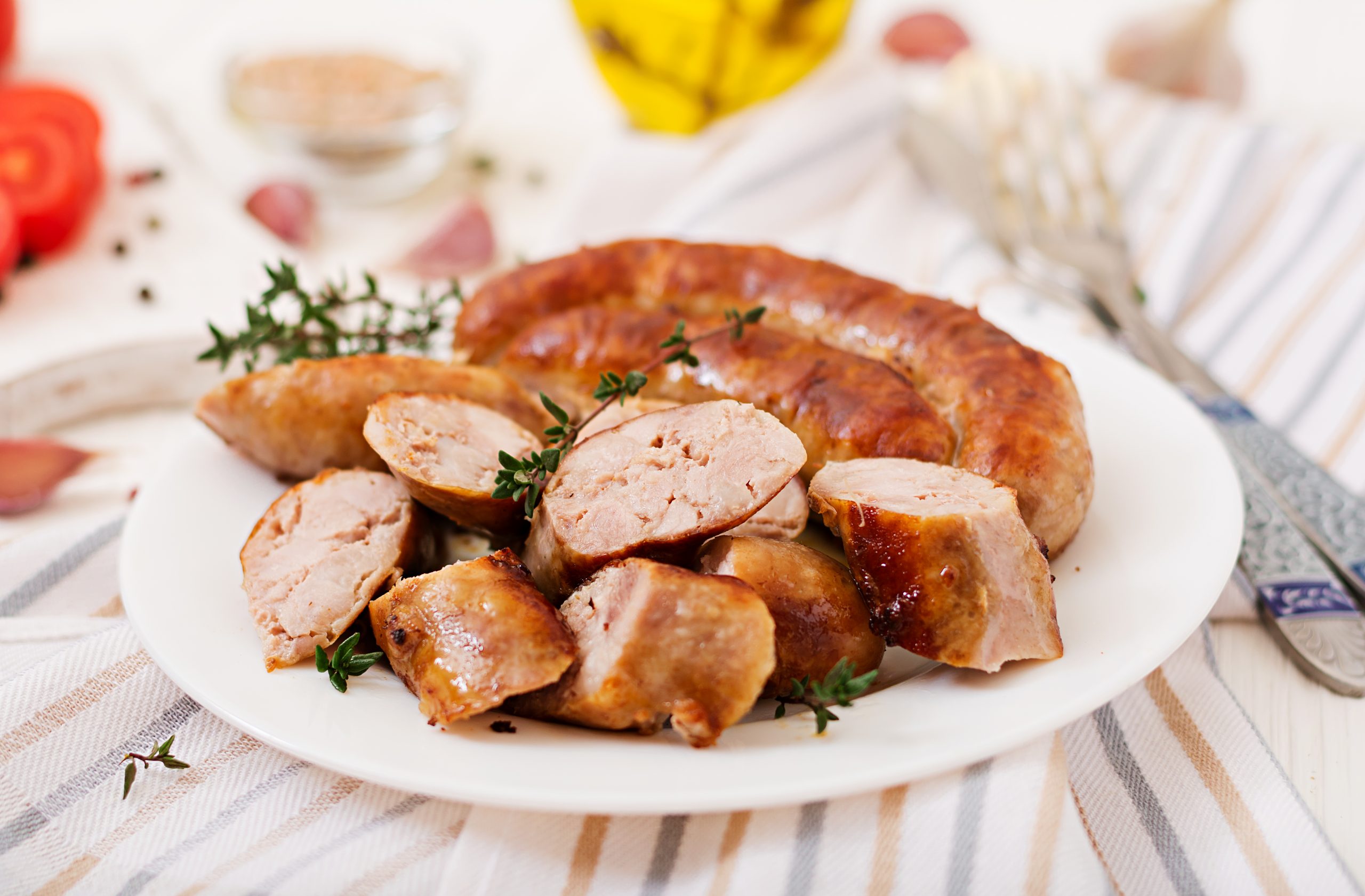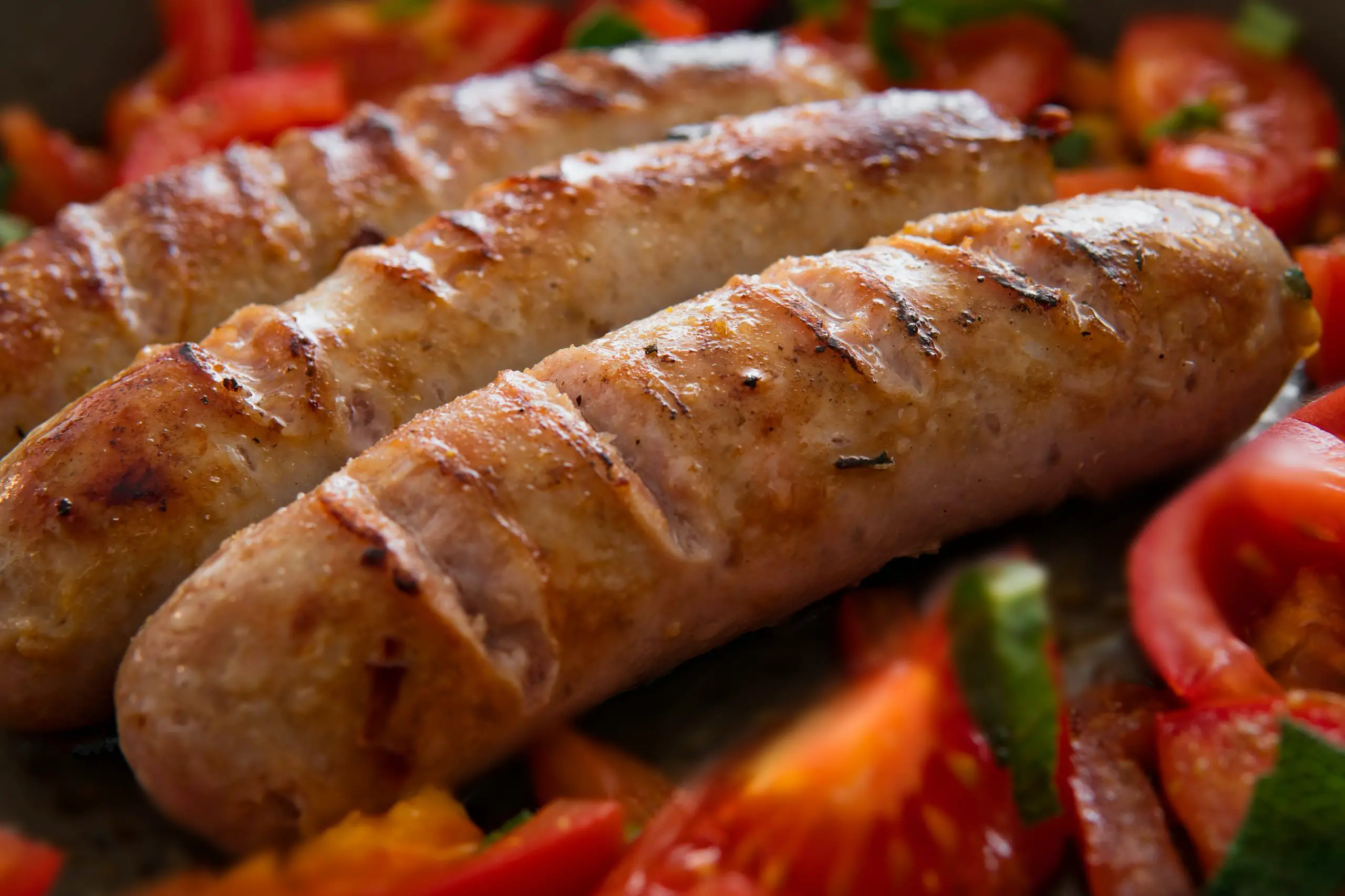This article is a perfect help if you’re trying a quick, delicious way to have your favorite sausage any time of day. We hope this post will explain how to reheat sausages so you can enjoy them whenever you want. If you want to reheat chicken sausages, there are a few ways to do this perfectly.
However, there are some things you should consider before reheating your chicken sausages. One way is to use a pan. Ensure that the meat is fully cooked by using a thermometer. Another option is to use the microwave or air fryer.

How to Reheat Chicken Sausages?
The ideal method is to use a microwave or a pan. You can reheat sausages covered in sauce (such as in a sausage casserole) in a slow cooker, on the stove, or in the microwave. To ensure that your sausages heat through without burning or drying out, think about halving them lengthwise before reheating.
1. Using the Microwave to Reheat Chicken Sausages
Using a microwave to reheat chicken or sausages is a convenient way to cook them quickly and easily. The time it takes to reheat them is about a minute or less, depending on the wattage of your microwave. The shorter cooking time also helps maintain the flavor of the sausages. Microwaves are also effective at retaining moisture in the filling. For best results, prick the sausages with a fork before placing them in the microwave.
You can also cover them with a damp cloth or paper towel to prevent the filling from drying. If you are unsure how long to cook sausages in a microwave, check the temperature. The internal temperature of the sausage should be around 74C or 165F. You don’t want to overcook them, as this can cause them to explode or dry out. In addition, make sure you use medium heat when you reheat sausages. If the sausages are frozen, defrost them before placing them in the microwave.
2. Using an Air Fryer to Reheat Chicken Sausages
Using an air fryer to reheat chicken sausages can be a great way to use leftovers. You can cook the chicken sausages in your air fryer and reheat them in a microwave or an airtight container. However, you must be sure to make sure that the sausages are fully cooked inside. If the sausages are undercooked, they may cause food poisoning. The cooking time for sausages varies depending on the thickness and size of the sausages.
You might need to modify the cooking time to suit your type of sausage because every air fryer operates differently. It would be best if you also were careful not to overload the air fryer, which can cause the sausages to overcook. Also, sausages from turkey or vegan meat may need additional cooking time. However, other sausages, such as breakfast or smoked, may need a shorter cooking time.
3. Using an Oven to Reheat Chicken Sausages
You can reheat chicken sausages using an oven. First, put the sausages on a non-stick baking sheet. If you want, you can cover the baking sheet with aluminum foil to prevent the juices from dripping out. After about 10 minutes, check the temperature of the oven and leave the sausages in for an additional five minutes.
After this time, you can serve the sausages. The next step is to prick the sausages with a fork, which will help with even cooking. You should also cover them with a damp cloth if you’d like. A damp cloth will also help prevent the sausages from drying out.
4. Using a Pan to Reheat Chicken Sausages
Using a pan to reheat chicken sausages is a convenient and effective method for preparing a quick meal. It prevents the need to heat a stove or oven and allows you to reheat food in your home. Before you start, be sure that the sausages are thawed properly. After that, place the sausages in the pan and heat them over medium heat. Cook the sausages for about four minutes on each side. Once cooked, they should remain warm but not mushy.
If you do not have a microwave or a stovetop, you can reheat your chicken sausages by baking them in the oven. The ideal temperature for this process is 350 degrees Fahrenheit. The chicken sausage should cook for about 8 minutes per side. Once cooked, store them in an airtight container. They will stay hot for up to four days. Once cooled, you can reheat them using the same methods as above or in the microwave.
Using a Meat Thermometer to Tell if Sausage Cooked
A meat thermometer is the best way to ensure that your sausages are cooked properly. While probing can be used to check the internal temperature, it can also release too much juice, so it’s important to check the sausage with a thermometer to ensure it’s cooked through.
If you want to cook sausages safely and quickly, use a meat thermometer. Generally, sausages are cooked when the internal temperature reaches 155 to 165 degrees Fahrenheit. To test a sausage’s readiness, insert a meat thermometer into the thickest part of the sausage or the end. Stick the thermometer into the meat for three seconds.
How can you Reheat Sausage Without it Becoming Dry?
Sausages can be reheated. Utilizing the microwave or stovetop is the best option. Before reheating, you might want to chop your sausages in half lengthwise; this will help them cook through without burning or drying out.
If you plan to reheat a sausage meal, you must store it in the refrigerator or freezer within two hours and eat it within three days. Food should be cooked in a high-power microwave oven for one to two minutes, stirring between bursts, until it is heated or the internal temperature reaches 75 degrees Celsius or 165 degrees Fahrenheit.
In addition, you can reheat sauce-covered sausages (such as those in a sausage casserole) in the oven, the stovetop, or a slow cooker. For 60 seconds before serving, let the heated sausages rest in the warm appliance. Only add a little water to prevent it from drying out during heating.
How do you Freeze Chicken Sausages?
Yes, sausages freeze excellently, exactly like other foods. The best approach to freeze sausages is to flash freeze them first, then transfer them to a larger freezer bag. Refrigerated sausages will maintain their optimum quality for up to six months, but they will still be safe to consume after that.
The less air your sausages are exposed to, the less probable that freezer burn will occur. Use a vacuum sealer, blow the air out of the freezer bag with a straw, or soak it in water before sealing it to get rid of the air. You could also use your hands, although that will be less effective.
The plastic wrap gives the sausages a second layer of protection, which reduces the likelihood of freezer burn even further. Before you bag your sausages, flash-freezing them keeps them from sticking together and makes it simpler to retrieve the amount you want to reheat.
What is the Shelf Life of Sausages?
Are you curious about the shelf life of sausages in a safe environment? The kind of sausage you have on hand makes a difference. We combed through the records of the United States Department of Agriculture’s Food Safety and Inspection Service, the public health organization in charge of keeping our food supplies safe and appropriately labeled, to determine the real shelf life of sausages once and for all. Utilize the advice below:
Room Temperature: When cooked meat is kept at room temperature for an extended period, it attracts dangerous bacteria. Sausages should always be refrigerated within two hours of cooking.
Refrigerate Sausages: Sausages should be heated up again within four days of being placed in the refrigerator. This will guarantee that they are safe for your health and are still fresh. Frozen sausages should be reheated within six months of storage to maintain their quality.
This study investigated the impact of Doenjang powder on the quality and shelf-life of chicken sausages. Sixty percent chicken breast flesh, twenty percent chicken skin, and other ingredients were used to make the chicken sausages. According to the DP addition level—0, 2, 5, and 8%—the sausages were separated into four treatments. For four weeks, the sausages were kept in a refrigerator (5 C) in a vacuum-sealed container.
How can I tell if the Sausage is Bad?
The first warning signs of spoiled sausage include discoloration and an unpleasant odor. Bad sausages may have mold on them and have an unpleasant flavor. Another warning sign, particularly with fresh sausages, is a slimy feel.
Although sausages are a fantastic source of protein, frequent consumption is not recommended. A butcher’s fresh sausages will be marked with an expiration date. Knowing the age of your sausages will help you determine whether they are safe to consume.
How to Store Sausages?
Start by allowing the leftover sausages to cool to room temperature before storing them. Put your sausages in an airtight container after wrapping them in plastic wrap. Put the container into the refrigerator. Sausage will remain fresh in the fridge for at least four days when properly stored.
Your sausages won’t dry out if you wrap them in plastic since the moisture is retained. If you prefer parchment paper over plastic wrap, it will work just as well. If you plan to keep the sausages for no more than a couple of days, you can completely remove them.
Conclusion
Sausages can be reheated repeatedly, and it is safe to do so. It depends on whether it’s a good concept. The flavor of the sausage will deteriorate as they become drier and more frequently reheated. Most chicken sausages, like the chicken sausage from True Story Foods, are pre-cooked, which makes preparation simple. Put your chicken sausages in a pan, sear them well, or grill them for a smokey flavor.

